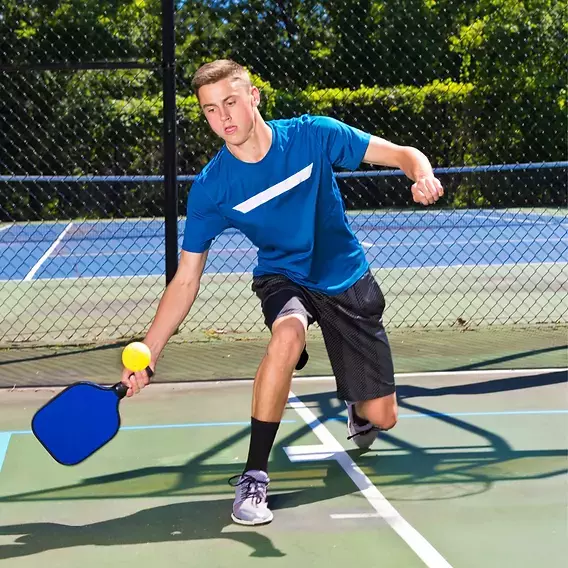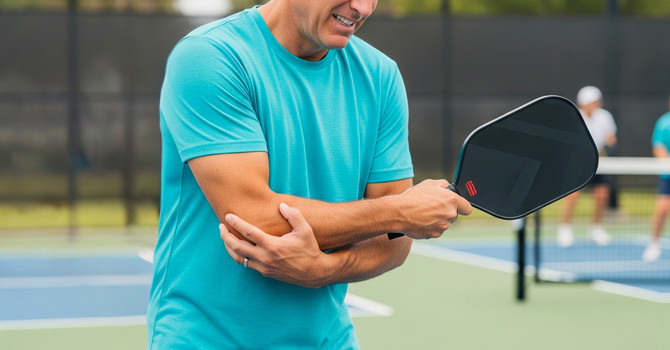
Have you ever felt a dull ache or a sharp pain on the outer part of your hip—especially after a few intense games of pickleball? You’re not alone. Hip pain on the outside of the leg is more common than many people realize, and one cause is a condition called trochanteric bursitis. In this article, we’ll explore what bursae are, why hip bursitis happens, how it’s linked to pickleball, and what you can do about it. We’ll also discuss methods to improve body mechanics and avoid this nagging problem.
What Is a Bursa, and Why Does It Matter?
A bursa is a small, fluid-filled sac located near joints throughout the body. According to the American Academy of Orthopaedic Surgeons (AAOS), bursae reduce friction between bones, tendons, and muscles, acting like tiny cushions to keep moving parts from rubbing painfully against one another. If a bursa becomes inflamed, you’ve got bursitis—and that means pain. In the case of the hip, the most commonly affected bursa is near a bony bump on the thigh bone (the femur) called the greater trochanter. That’s why it’s called trochanteric bursitis. When the trochanteric bursa gets inflamed, pain often starts on the outside of the hip and can spread down the leg. The discomfort might feel sharp at first, then later become more of an ache. It might even get worse at night, especially if you lie on the affected side.
Why Does Bursitis Happen?
Here’s the simple answer: stress or strain on the bursa causes inflammation. But the harder question is what triggers that stress in the first place. There are several possible culprits:
- Muscular Issues: A weak or tight gluteus medius (one of your main butt muscles) can alter how your hip moves.Other muscles in the hip, thigh, and lower back may also be out of balance, increasing friction around the bursa.
- Body Mechanics: Incorrect posture or stride can place extra pressure on the hips. Abnormal movement patterns—such as rolling your foot inward while walking—may aggravate the bursa.
- Overuse or Repetitive Motion: Sports that require lots of side-to-side movement, such as pickleball, can irritate the bursa over time.
- Previous Injuries: Past hip or back problems can change how you move, potentially placing extra load on the outer hip.Because so many different factors can lead to bursitis, there isn’t a one-size-fits-all fix.
That’s why people with the same basic diagnosis—trochanteric bursitis—might require different treatments.
Pickleball’s Role in Hip Pain
Pickleball is a fast-growing sport appreciated for its quick rallies and lively pace. Unfortunately, these very features can also strain your hips:
- Side-to-Side Movements: Pickleball has rapid lateral movements. If you’re not used to these, the bursa on the outer hip can become irritated.
- Frequent Pivoting: Pivoting requires sudden shifts in body weight, and if your hip stabilizers (like the gluteus medius) are not strong enough, the bursa can suffer.
- Repetitive Bending and Squatting: Bending to pick up the ball or hit low shots also adds stress to the hip joint area.Combine these motions with tight or fatigued muscles, and you have a recipe for persistent hip pain.
That said, not everyone who plays pickleball will develop bursitis. Many factors—like muscle strength, flexibility, and personal biomechanics—affect whether you’ll have issues.
Recognizing the Symptoms
Symptoms of trochanteric bursitis might include: Pain on the outer part of the hip, sometimes extending down the thigh.Discomfort when lying on the affected side. Sharp pain that eventually turns into a dull ache. Worsening pain after prolonged walking, climbing stairs, or getting up from a chair. These signs can resemble other hip problems, so it’s best to get a proper medical evaluation. A Sports Chiropractor or Physical Therapist can run special tests to diagnose bursitis and rule out other issues, such as IT band syndrome or tendonitis.
First Steps to Managing Hip Bursitis
If you suspect bursitis, you might benefit from using basic "RICE" principles:
- Rest: Reduce activities that worsen your hip pain, especially high-impact exercises or frequent side-to-side movements.
- Ice: Applying ice to the outer hip for about 15–20 minutes can soothe inflammation.
- Compression: While not always needed for the hip, some people find light compression wraps useful for added support.
- Elevation: Although elevating the hip is trickier, lying flat and propping up your leg slightly can be comfortable if swelling is significant. Over-the-counter anti-inflammatory medications (like ibuprofen) may help reduce pain, but check with a healthcare provider before starting any medication.
In more severe cases, a doctor might recommend corticosteroid injections to calm the inflammation. However, none of these methods will solve the core problem if you don’t address the underlying cause of the bursitis.
Target the Source: Correcting Underlying Problems
1. Sports Rehab - Sports Chiropractors specialize in spotting imbalances in strength or flexibility. They can create a custom exercise plan that: strengthens weak muscles (often the gluteus medius, gluteus minimus, and core stabilizers), improves flexibility in tight areas (such as the hip flexors or hamstrings), re-trains your body mechanics to reduce extra friction on the bursa.
2. Strength Training - When you think of pickleball, you might not immediately picture heavy weights. Still, well-rounded strength training supports healthy hips and keeps the bursa happy. Try including:
- Lower Body Exercises:Front squats, split squats, step-ups, lateral lunges, deadlifts
- Upper Body Exercises:Overhead press, bench press, rows, pull-ups, push-ups, bicep curls, and tricep extensions
Work each major muscle group twice a week, aiming for 2–3 sets of 8–12 repetitions.
3. Mobility and Flexibility - Flexible joints move more smoothly, which reduces friction:
- Hip Mobility Routines: Spend 10–15 minutes, 2–3 times a week, doing gentle hip openers and torso rotations.
- Foam Rolling: Lightly rolling out tight muscles in the hips, thighs, and back can improve your range of motion and reduce muscle tension.
- Stretching: Consider dynamic stretches before a pickleball match and static stretches afterward to help muscles recover.
4. Mastering Fundamental Movements - Pickleball includes frequent pivoting, lunging, and swinging, so you’ll need to master certain moves:
- Arm and Shoulder Control: Practice swinging in various directions without straining your shoulder or elbow.Spine Movement: Work on torso rotations (with or without a stability ball) to keep your core active and stable.
- Hip Adduction and Abduction: Side steps, band walks, and other lateral movements strengthen the glutes and stabilizers.
- Knee and Ankle Mechanics: Pay attention to proper knee bending and ankle alignment, so the load is spread evenly.
5. Refine Your Swing Mechanics - Your pickleball swing doesn’t have to be fancy, but it should be efficient:
- Use a Pendulum Swing: Stand in a slight squat, bring the paddle back gently, and swing forward. Avoid overly big backswings or wild wrist actions.
- Hit the Ball Out Front: Focus on contacting the ball at its peak height for a more controlled shot. Keeping your arm stable also helps reduce stress on the hip.
6. Footwork and Ready Position - In pickleball, it’s “feet first, swing second”:
- Proper Footwork: Stay on the balls of your feet, ready to move laterally or forward and backward.
- Ready Position: After each shot, return to a slightly bent, athletic stance.
This positions your body to react quickly and reduces awkward lunges that strain the hip.
Avoiding Future Flare-Ups
1. Adequate Rest - Avoid playing pickleball every single day—especially if your hips feel sore. Giving your body at least one full rest day a week can prevent overuse injuries. Try to space out your intense pickleball sessions with lighter activities, like walking or gentle cycling.
2. Supportive Footwear - Shoes matter. Look for court shoes designed for lateral movements. If you’re prone to pronation or supination (foot rolling inward or outward), consider using custom orthotics or insoles recommended by a podiatrist.
3. Warm-Up and Cool-Down - A 5–10-minute warm-up before hitting the court raises your muscle temperature, boosts circulation, and prepares your hips for motion. Afterward, cool down with slower movements or light stretches to help flush out lactic acid and reduce stiffness.
4. Listen to Your Body - If something feels off, don’t push through the pain.
Many injuries get worse because people ignore early warning signs. Check in with a rehab professional if pain persists.
Final Thoughts
Hip pain on the outside of the hip—especially among pickleball enthusiasts—often points to trochanteric bursitis, an inflamed bursa near the greater trochanter of the femur. But treating bursitis isn’t just about icing or popping pills. The real key is uncovering why the bursa got inflamed in the first place. This might mean improving muscle balance, fixing posture, or refining your pickleball technique.Pickleball is supposed to be fun, and hip pain can definitely spoil the party. The good news? With the right combination of rest, targeted exercises, proper body mechanics, and maybe a bit of professional guidance, most cases of trochanteric bursitis can heal without surgery or invasive treatments. Take the time to strengthen your hips, work on your form, and pace yourself on the court. Your bursa will thank you!
.jpg)


.jpg)


